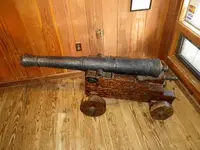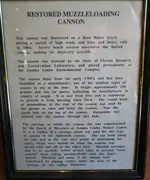Early 19[SUP]th[/SUP] Century. Both research and physical evidence suggest the existence of an as yet unidentified British frigate wrecked off Highland Beach. The wreck is reportedly located in close proximity to an area known as Yamato Rock.
[1] Daryl Wilmoth, a resident of Boca Raton discovered a 5-foot iron cannon and a large exposed ballast pile off the beach following Hurricane Cleo in 1967. Wilmoth was diving on the ballast pile with a friend about three months after the hurricane, when he discovered the exposed cannon in about ten feet of water. Wilmoth reportedly located the cannon at the north edge of the Ocean Hearth Restaurant. He returned to the site and was able to raise the cannon using 55-gallon oil drums and float it to the city launching ramp on Palmetto Park Road. The gun turned out to be a 4-pounder cannon. Wilmoth later discovered markings on it that revealed its weight (837 pounds) and where it was cast (London). With the help of experts at the Smithsonian Institution, Wilmoth also learned that the makers of the cannon were Bailey, Pegg & Co., and that the company operated in London and Staffordshire, England. The Bailey, Pegg & Co. Foundry operated in London between 1812-1866, initially at the Gunwharf, Wapping, then laterally at 81 Bankside, SE. They specialized in supplying iron guns to arm merchant ships and also to the established trading post in faraway places. Wilmoth displayed the cannon at his marine shop in Boca Raton for many years. Eventually, the cannon was placed in storage in his garage until a proper home could be found. He approached the Boca Raton Historical Society but nothing much was ever done and the cannon didn’t go anywhere. Finally, in 1993 Wilmoth decided to clean out his garage, something he had been putting off for years. He decided to donate the gun to the Gumbo Limbo Nature Center. (Note: For additional reading see “Shipwreck Relic Boca Diver Donates Cannon He Recovered to Gumbo Limbo” by Sherri Winston in
Sun Sentinel, January 15, 1993. The Ocean Hearth was located on A1A one mile north of Palmetto Park Road according to an advertisement found in the
Palm Beach Post dated April 12, 1965.) (500)
[1] Although the rock is depicted on a USGS Delray Beach Topographical map as “Jap Rock” and is often referred to as “Jap Rock” or “Japanese Rock” by local boaters and divers, according the USGS the politically correct name of the place is Yamato Rock. Located within the town of highland Beach, northeast of Boca Raton and 1.9 miles southeast of the community of Yamato; the name honors the Japanese settlers who settled Palm Beach County in the early 20[SUP]th[/SUP] century. The Yamato Colony was an attempt to create a community of Japanese farmers in what is now Boca Raton. Florida officials recruited young Japanese men to settle the area but due to various difficulties the colony never grew very large. Henry Flagler created the Model Land Company to hold title to land granted to his Florida East Coast Railway and sold the land to recent immigrants to increase business for his railroad. Jo Sakai, a native of Miyazu, Japan graduated from New York University and later purchased 1,000 acres of land from the Model Land Company in 1903. He recruited immigrants from his hometown. Many eagerly sought a better life in a new land. Several hundred Japanese farmers grew pineapples. The crop was shipped via the railroad. However, a pineapple blight destroyed the crop 1908. To compound the problem, the farmers had difficulty competing with the cheaper and earlier ripening pineapples imported from Cuba. The colony gradually declined until it was dispersed after the onset of World War II.
Hope this helps





